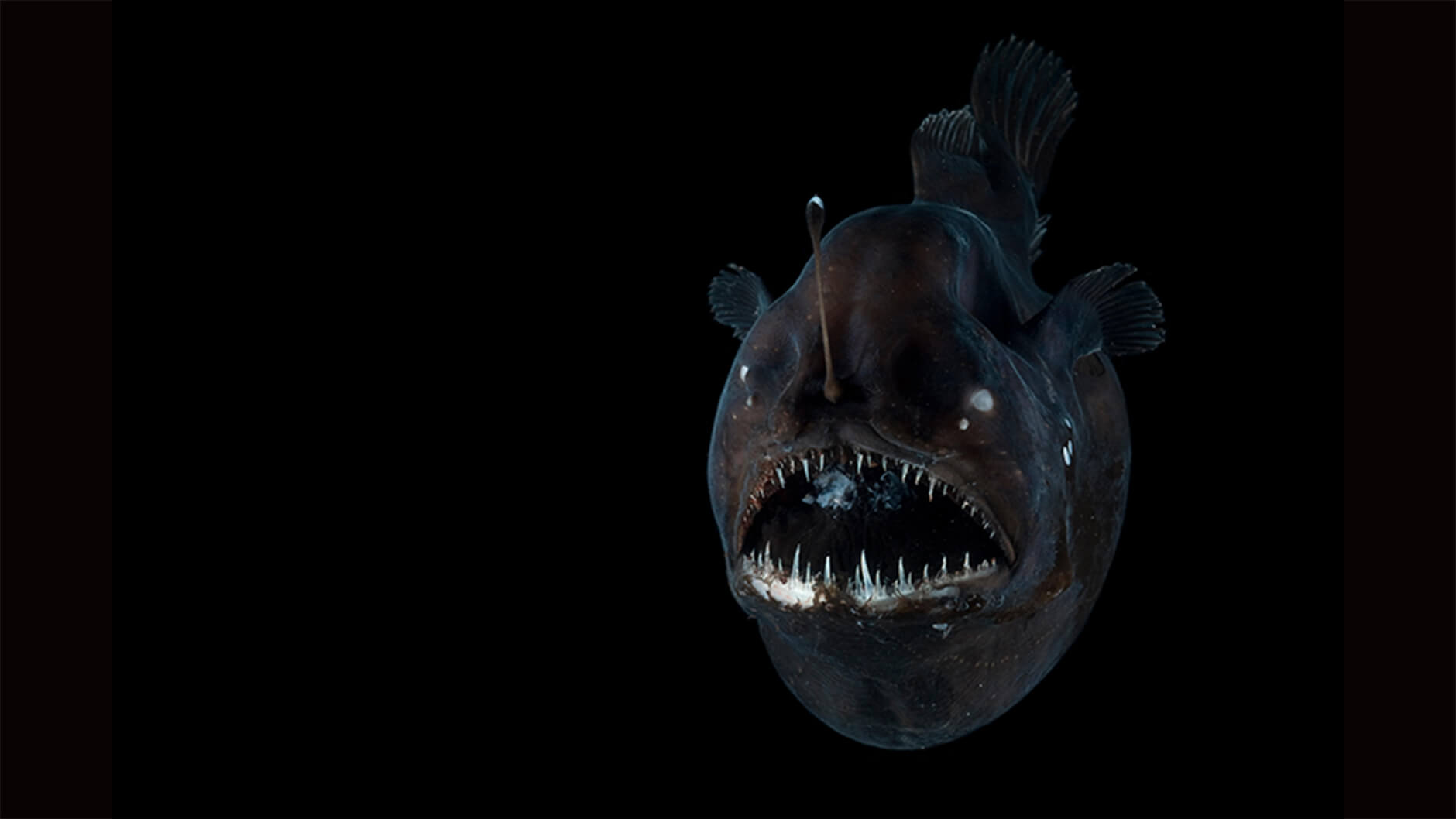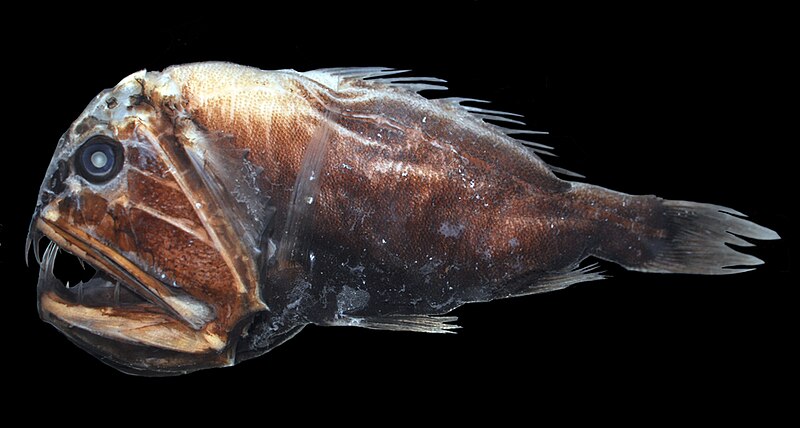The deep sea is home to some of the most fascinating and terrifying creatures on the planet, and the anglerfish is no exception. These fish are among the most intimidating and scary-looking species in the ocean. With their large mouths filled with significantly sharp teeth and deadly
lures swaying overhead, it’s hardly surprising that these creatures are the stuff of nightmares. Despite living in absolute darkness, anglerfish have remarkably discovered innovative methods to survive and thrive in a seemingly hostile environment.
You are reading: 5 Types Of Scary Looking Angler Fish
Whether roaming through murky depths or lurking amongst coral reefs, the crafty anglerfish can easily blend into its surroundings. This article will explore five types of scary-looking anglerfish that will send shivers down your spine.

5 Types Of Scary Looking Angler Fish
Fangtooth Anglerfish

The Fangtooth Anglerfish, also known as Anoplogaster cornuta, is a species of deep-sea fish found in temperate and tropical oceans worldwide. This fish is commonly seen between 600 and 6,500 feet but has been observed as deep as 16,000 feet.
The common fangtooth has a distinctive appearance and grows to a total length of about 18 cm (7 in). Adults are dark brown to black, the head is very large, bony, and finely sculptured but does not bear any spines.
Read more : 10 Types Of Pond Turtles
The eye is small, and the gill rakers have bony bases and are tooth-like. The body is deepest just behind the head, tapering rapidly to the caudal peduncle. The mouth is well-armed with sharp fangs, and the skin is granular.
Fangtooths spawn from June to August. The Fangtooth Anglerfish is a predator and feeds on other fish, crustaceans, and cephalopods. They are themselves preyed on by such fish as tuna, marlin, and albacore. It is a schooling fish and is often found in small groups.
Black Seadevil
The Black Seadevil, also known as Melanocetus, is a small deep-sea anglerfish belonging to the family Melanocetidae. Here are some interesting facts about the Black Seadevil:
– The Black Seadevil is found in tropical to temperate waters of the Atlantic, Indian, and Pacific Oceans, with one species known only from the Ross Sea.
– Black Seadevils are characterised by a gelatinous, mostly scaleless, globose body, a large head, and a generous complement of menacingly large, sharp, glassy, fang-like teeth lining the jaws of a cavernous, oblique mouth.
– These teeth are depressible and present only in females. Some species have a scattering of epidermal spinules on the body, and the scales (when present) are conical, hollow, and translucent.
– Like other anglerfishes, Black Seadevils possess an illicium and esca.
– The single dorsal fin is positioned far back from the head, larger than and above the retrorse anal fin. Females have large, highly distensible stomachs which give the ventral region a flabby appearance.
– In life, Black Seadevils are dark brown to black. The skin is extremely soft and easily abraded during collection or even by simple handling.
– The female Black Seadevil has a unique adaptation to attract prey. It has a “fishing pole” on its head, which is an elongated dorsal spine that ends in a bioluminescent bulb. The tip of the pole lights up in the dark, attracting prey. When hungry animals get close, the Black Seadevil can quickly snatch them up with its cavernous mouth.
– The male Black Seadevil is much smaller than the female and has no lure. Instead, it has well-developed olfactory organs that help it locate females.
– Predators of Black Seadevils are not well known, but include lancetfish.
– The Black Seadevil was first captured on video in 2014 by the Monterey Bay Aquarium Research Institute.
Overall, the Black Seadevil is a fascinating and unique deep-sea creature with a distinctive appearance and interesting adaptations.
Goosefish
Goosefishes are a type of anglerfish found in the Arctic, Atlantic, Indian, and Pacific Oceans. They live on sandy and muddy bottoms of the continental shelf and continental slope, to depths of more than 1,000 m (3,300 ft). Here are some interesting facts about Goosefish:
– Goosefish have a very large head with a large mouth that bears long, sharp, recurved teeth.
– Like most other anglerfishes, they have an angling apparatus (illicium) that bears a bulb-like or fleshy lure (esca).
– The first spine of the spinous dorsal fin has been modified as an angling apparatus (illicium) that bears a bulb-like or fleshy lure (esca).
– The gill opening does not extend in front of the pectoral fin base.
– The largest individuals may exceed 1.5 m (4.9 ft) in length.
– Several of the large species in the genus Lophius, commonly known as monkfishes in northern Europe, are important commercially fished species.
– The liver of monkfish, known as ankimo, is considered a delicacy in Japan.
– Goosefishes are soft and flabby with wide, flattened heads and slender, tapering bodies.
– They may grow to a maximum length and weight of about 1.8 metres (6 feet) and 34 kilograms (75 pounds).
– Goosefishes generally live on the bottom, lying quietly or moving slowly about. They are carnivorous, and commonly “fish” for their prey, luring it near enough with the “bait” to be taken with a sudden snap. Fishes form the main part of the diet; various invertebrates and seabirds are also eaten.
– Goosefishes are sold as food in some regions.
Overall, Goosefishes are fascinating creatures with unique adaptations that allow them to thrive in their deep-sea environments.
Sea Devils
Sea devils are a family of deep-sea anglerfish known as the Ceratiidae. Here are some interesting facts about sea devils:
– Sea devils are found in all oceans from the tropics to the Antarctic.
– They are among the most widespread of the anglerfishes and are large and elongated.
– Females of the largest species, Krøyer’s deep-sea anglerfish (Ceratias holboelli), reach 1.2 m (3.9 ft) in length.
– The family name Ceratiidae may be translated from the Greek keras, meaning “horn,” referring to the bioluminescent lure that projects from the fishes’ forehead.
– Sea devils have a long, slender body with a large head and a mouth that is lined with sharp, translucent teeth.
– They have a bioluminescent lure on their forehead that they use to attract prey.
– The males of some species have a parasitic lifestyle and are much smaller than the females.
– The males have a specialized olfactory organ that they use to locate females.
– Sea devils are not commonly seen and are rarely caught by fishermen.
– In 2014, a rare black sea devil was caught on film for the first time off the coast of California at a depth of about 1,900 feet.
Read more : 10 Types Of Butterfly
Overall, sea devils are fascinating creatures with unique adaptations that allow them to thrive in their deep-sea environments.
Lophiiformes
Lophiiformes is an order of bony fish that includes more than 300 species of anglerfish. Here are some key facts about Lophiiformes:
– The name Lophiiformes comes from the Greek word “lophos,” meaning crest or tuft, and refers to the modified dorsal fin that acts as a lure for prey.
– Lophiiformes are found in all the world’s oceans, from the surface to depths of more than 5,000 meters (16,400 feet).
– The first spine of the spinous dorsal fin has been modified as an angling apparatus (illicium) that bears a bulb-like or fleshy lure (esca).
– Lophiiformes are carnivorous and feed on a variety of prey, including fish, crustaceans, and cephalopods.
– Some species of Lophiiformes are commercially important, such as the monkfish (Lophius spp.) in northern Europe.
– The eggs of Lophiiformes are unique among fish in that they are laid in a thin sheet of transparent gelatinous material that can be more than 10 meters (33 feet) long.
– The larvae of Lophiiformes are free-swimming and have elongated pelvic fins that resemble fishing lines.
– Lophiiformes are a diverse and often bizarre-looking group of fish, with some species having large heads, sharp teeth, and bioluminescent lures.
– Lophiiformes are sometimes referred to as “anglerfish,” although this term can also be used to describe individual species within the order.
Overall, Lophiiformes is a fascinating order of fish that includes some of the most unique and interesting creatures in the ocean.
FAQS
1. What are anglerfish?
Anglerfish are a type of deep-sea fish that are known for their large mouths filled with sharp teeth and a bioluminescent lure that they use to attract prey.
2. Where are anglerfish found?
Anglerfish are found in all the world’s oceans, from the surface to depths of more than 5,000 meters (16,400 feet).
3. What are some adaptations that anglerfish have to survive in the deep sea?
Anglerfish have developed a number of adaptations to survive in the deep sea, including bioluminescent lures, natural camouflage, and the ability to swallow prey that is twice their size.
4. Are anglerfish dangerous to humans?
Most species of anglerfish are not dangerous to humans, as they live in the deep sea and are rarely encountered. However, some species have been known to attack humans who venture too close.
5. What are some other scary fish that live in the ocean?
There are many other scary fish that live in the ocean, including the goblin shark, the viperfish, and the fangtooth.
Source: https://petstutorial.com
Category: Animals










